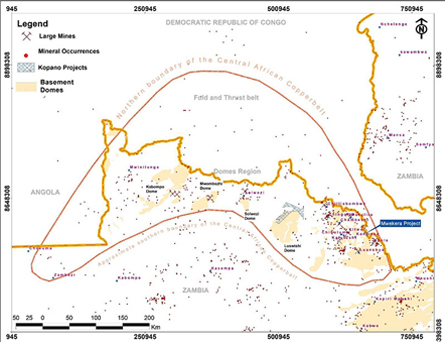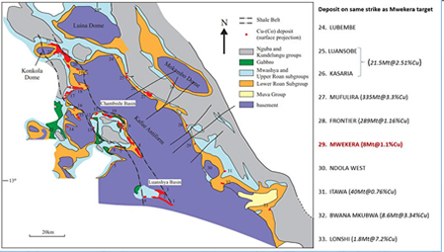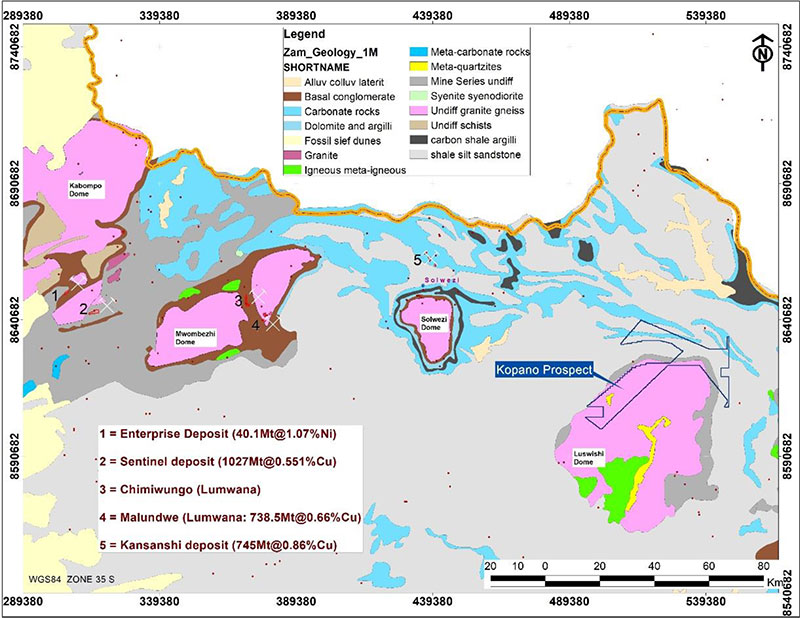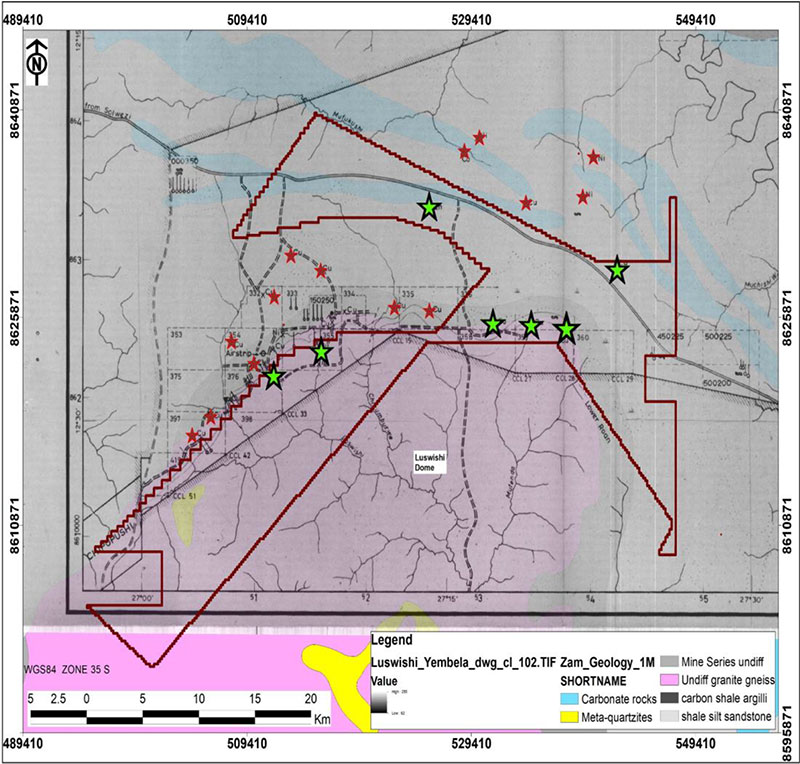Notable deposits of the Copperbelt belt include the following:

- Sentinel – 1190 million tonnes at 0.5% copper
- Kansanshi – 745 million tonnes at 0.86% copper
- Lumwana – 738.5 million tonnes at 0.66% copper
- Nkana – 690 million tonnes at 2.5% copper
- Konkola – 685 million tonnes at 3.1% copper
- Nchanga – 580 million tonnes at 3.6% copper
- Mufulira – 335 million tonnes at 3.3% copper
- Luanshya – 290 million tonnes at 2.8% copper
- Frontier – 289 million tonnes at 1.16% copper
- Chambeshi – 240 million tonnes at 2.3% copper
- Chambeshi southeast – 117 million tonnes at 1.87% copper
Kopano’s current exploration permits covering a total of 576 square kilometers provide a great combined potential for near-term resource and production growth opportunities.

The estimated resource comes from drilling data which covered only a 2.4 km portion of the Mwekera concession, out of the available 7 kilometers of untested Lower Roan rocks. No doubt there is excellent room and potential to expand the resource when the entire prospective ground is drill tested thoroughly.
The Mwekera project lies in the domes region, a Neoproterozoic metallogenic province which hosts several world-class copper-cobalt deposits of the Central African Copperbelt (Zambia and Congo DR). Copper deposits found in this region show many characteristics consistent with their classification as stratabound/stratiform sediment-hosted deposits. Sediment-hosted deposits are so-called because they are confined to specific narrow layers within a sedimentary sequence but do not necessarily follow sedimentary bedding.

Copper mineralisation occur in multiple lithologies and stratigraphic positions and vary in type of mineralisation and alteration, but share vital characteristics. Deposits occur at the lowest redox boundary within reduced facies rocks above oxidised facies rocks. This redox boundary may be stratigraphically or structurally controlled, consequently is positioned at different levels throughout the CACB. Many deposits are positioned in the vicinity of macro-structural features, primary growth faults and large anticlines and synclines formed during Lufilian inversion of such faults.
Source of metals in the Katangan basin is generally thought to come from the basement but ideas on how and when they got to present deposition sites abound. Some scholars postulated metal source to be from convective recirculation of hot basinal fluids driven by high geothermal gradients associated with crustal rifting in the Lufilian (epigenetic model). Many others believe metals were derived from erosion of basement with sediments transported in rivers and adsorbed on clays and deposited contemporaneous with host rocks (Syngenetic model).
The widely accepted genetic models are the early, intermediate to late diagenetic models which developed from studies of diagenetic processes in sedimentary rocks (Brems et al., 2009; Sillitoe et al., 2017; Sweeney and Binda, 1989). These models contend that sulphides were precipitated during large-scale chemical reaction of host rock and its pore fluid with metalliferous brine (Bartholome et al., 1971; Annels, 1984; Selley et al., 2005; Unrug, 1988). Copper and its accompanying cobalt or silver were introduced during diagenesis of the host sediments (Brown, 1997; Hitzman et al., 2005).

At Kansanshi copper-gold deposit, mineralisation occurs in 3 dominant styles as follows;
- Steeply dipping, sheeted quartz-carbonate-sulphide veins,
- Sediment-hosted, mineralised haloes to the veins, and
- Sulphide crackle and stockwork breccias in zones of higher veining density.
The veins range in thickness from a few millimeters to about 6 m and are predominantly vertical to subvertical trending in diverse directions but in general they follow the NW-SE trending zone. Individual veins mostly have N-S trends and strike lengths vary from hundreds of metres to about 1.2 km with widths of roughly 200 m and vertical dimensions not exceeding 300 m deep.
Similarly, copper mineralisation at Kopano’s Luswishi project occurs dominantly as chalcopyrite in calcite veins which have thicknesses varying from 10 cm to about 10 m with grades ranging from 0.94% copper to 11.71% occurring at depths of between 80 – 600 m in Upper Roan dolomites. Roan Selection Trust (RST) in the 1960’s cored a total of 14 boreholes targeting stratiform mineralisation in the Lower Roan, 9 of which intersected copper mineralisation. The drillholes went through Upper and Lower Roan group rock units before terminating in the granite-gneiss basement. Inspection of the core revealed the Upper Roan carbonates have higher magnetic susceptibilities and hosts fine disseminations and blebs of chalcopyrite and bornite. These 9 cored boreholes were later utilised to compute a crude resource estimate amounting to 800,000 tonnes copper grading at 2.2% (WGM, 1991).
RST collected good gridded data along the Basement-Katanga contact in the northern flank of the Luswishi dome (Luswishi project). Their targeting exploration model was stratiform deposit styles. Stream sediment sampling was conducted alongside machine auger drilling. Stream sediment assays revealed anomalous cobalt concentrations ranging between 5.8 – 32.9 ppm. In the northwest corner of the Kopano licence (RST’s sheet 376) a highly anomalous area was outlined by auger drilling with values of copper up to 12,600 ppm and values of cobalt maxing at 2600 ppm. These results so motivated RST that they hurriedly sunk in some boreholes such as RGL4 without ground magnetic and IP geophysical support and therefore its possible they could not have tested the most sulphide-rich parts of Luswishi north (WGM, 1991).
northwest of Mufulira, anomalous range of 150 – 400 ppm Cu over 300 m-thick deeply leached soils overlying ore mineralisation with 25 – 100 ppm Cu established as background. Similar ranges were obtained in Lufubu North on soils overlying sub outcropping ore (200 – 550 ppm Cu anomalous) with background values in the range 30 ppm to 75 pp copper. Anomalous cobalt range overlying orebodies was established to be between 20 – 80 ppm with background values in the range 7 – 14 ppm. As long as the peneplain topography was flat anomalies peaked directly overlying sub outcropping mineralisation.

Historical drillholes were oriented towards the dome (drilled southwards) in anticipation to intersect typical Copperbelt-style stratiform copper mineralisation in Lower Roan rocks which shallowly dip at 30o away from the dome. But if the veins in this area are exactly similar to those at Kansanshi deposit (which strike N-S away from the Solwezi dome), it implies old drillholes where mis-aligned and mis-oriented parallel to the strike of the veins. Interpretations of geophysical data from the Rio Tinto project in the southwestern flank of the dome clearly shows structural lineaments radiating away from the dome. For this reason and observation of mineralised veins at Kansanshi, new exploration in the area should pay particular attention to the strike of vein mineralisation when planning and designing drillholes.
Overall, the Luswishi project has good exploration data generated by past explorers that is available for review to aid new exploration. These data sets include:
- Good gridded geochemical data
- Falcon/BHP/FQM/Vale and Anglo Spectrem geophysical data
- Airborne magnetics and radiometrics data at 400m spacing
- Historical drillholes stored at the chamber of mines/ZCCM-IH core yard in Kalulushi ∙ Recent drillholes completed by Vale (stored in Kalulushi/Geological survey)

